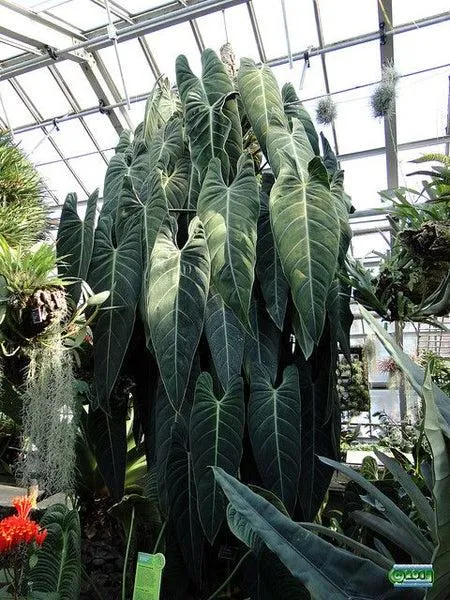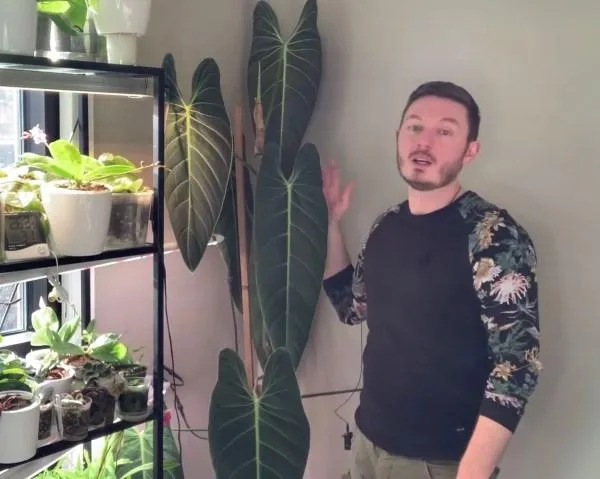A Comprehensive Guide to Philodendron melanochrysum Care
The philodendron melanochrysum, commonly known as the black knight philodendron, is a stunning foliage plant prized for its uniquely colored leaves. Native to southeastern Brazil, this philodendron variety boasts dark, nearly black leaves that seem to glow from within. Its incredible leaf colors and vining habit make it a real showstopper in any indoor landscape.
However, achieving the melanochrysum’s full beauty does require some work. As with all philodendrons, proper care is needed to keep this plant healthy and thriving. In this in-depth guide, I will share all the details on feeding, watering, lighting, and more to help you get the black knight philodendron looking its very best.
Lighting
Lighting is one of the most important factors in growing philodendrons successfully. The melanochrysum especially needs bright, indirect sunlight to maintain its gorgeous deep leaf colors. From my experience, a west- or east-facing window is ideal. Place the plant about 2 feet back from the window to filter the sunlight.
Provide supplemental lighting if natural light is lacking, such as from a grow light. Make sure the light is several inches above the foliage. The plant needs a minimum of 4-6 hours of direct or indirect sunlight daily. Too little light will cause leaves to become pale and lose their luster.
Water
The soil should be allowed to dry out between waterings, but never become completely dry. Feel the top 1-2 inches of soil to check moisture levels. I find that watering once every 7-10 days during the growing season (spring-fall) works well in most homes. Water less frequently in winter when growth slows.

Water thoroughly whenever the topsoil is dry. Pour water into the drainage holes until it runs freely out the bottom. Do not allow the plant to sit in water for more than 30 minutes. Overwatering is a common problem and can cause root rot.
Humidity
Philodendrons thrive in humid conditions similar to their native tropical rainforest habitat. The melanochrysum particularly benefits from higher humidity around 50-60%. You can achieve this by grouping plants together, using a pebble tray or humidifier, or running a cool mist humidifier nearby. Lack of humidity may cause brown or crispy leaf margins and edges.
Potting and Soil
Repot the melanochrysum annually in late winter or early spring when new growth starts. Select a pot that is 2-3 inches larger in diameter than the current one. Use a well-draining, organic potting mix specifically for houseplants. In a pinch, you can mix 1 part perlite into regular potting soil to improve drainage.
Philodendrons appreciate containers with drainage holes for excess water to escape. If reporting into the same container, refresh the top half of the soil. Always water thoroughly after potting to settle the roots.
Fertilizer
Feed the melanochrysum every 2-4 weeks during the active growing season with a balanced, water-soluble houseplant fertilizer. Dilute the fertilizer to half or quarter strength according to label instructions. Scratch a small amount of fertilizer into the topsoil rather than pouring it on, as excess can burn delicate roots. Stop fertilizing in winter when growth slows.

Pruning and Propagation
Philodendrons are vigorously climbing vines that respond well to pruning. You can shape and maintain the plant by removing unwanted growth or competing vines. Cut stems back to a strong lateral vine or node. The cut ends will quickly sprout new growth.
Water-or-soil propagation of philodendron cuttings is quite simple. Take 6-inch stem cuttings with at least 2-3 nodes, remove lower leaves, and stick the cut ends into damp soil. Keep the soil consistently moist in a warm spot until roots develop, which usually takes 2-4 weeks.
Pests and Diseases
Common philodendron issues include spider mites, scale, and mealybugs. Watch for tiny spider-like insects or cottony masses and wipe them away promptly with cotton balls dipped in rubbing alcohol. Prevent problems by maintaining proper care, such as watering correctly and boosting humidity.
Overwatering and poor drainage are the leading causes of root rot in philodendrons. Symptoms include yellowing or browning of lower leaves. Improve drainage and allow the soil to dry out between waterings. Cut away any mushy, darkened roots and repot in fresh soil.
In summary, the key aspects to achieving luscious philodendron melanochrysum foliage are:
– Bright, indirect light for 4-6 hours daily
– Allowing soil to dry out moderately between thorough waterings
– Keeping humidity around 50-60%
– Annual repotting and use of a well-draining potting mix
– Fertilizing regularly during growing season
– Pruning or propagation to maintain a pleasing shape
– Addressing pests or diseases promptly

With the right care tailored to its needs, the majestic black knight philodendron can thrive for many years, dazzling you with its stunning ebony leaves. Feel free to experiment until you find what works best in your growing conditions. The rewards are well worth your effort! Let me know if you have any other questions.
Philodendron melanochrysum Care Guide
| Light | Bright indirect light. Avoid direct sun which can burn leaves. |
|---|---|
| Water | Water when top 2 inches of soil are dry. Do not let sit in water. |
| Humidity | Prefers humid conditions above 50%. Mist leaves occasionally or place on pebble tray. |
| Temperature | Grow between 65-85°F. Will drop leaves below 60°F. |
| Soil | Welldraining potting mix. Do not let sit in soggy soil. |
| Fertilizer | Feed monthly spring-fall with dilute balanced fertilizer. |
| Pruning | Remove dead or damaged leaves/stems. Cut back vines to maintain shape. |
FAQ
-
What kind of light does a philodendron melanochrysum need?
These kinds of plants basically like bright, indirect light. Put them in a spot with sunlight for a good chunk of the day, but make sure it’s not sitting in direct sun beams. Too much straight sun could fry their leaves!
-
How often should I water a philodendron melanochrysum?
As long as the soil is mostly dry, around once every 1-2 weeks should do the trick. I like to stick my finger in the dirt – if it feels dry about an inch down, it’s time to water. At the same time, be careful not to overdo it. These guys don’t want soggy feet!
-
What kind of soil is best for a philodendron melanochrysum?
Most folks say a well-draining potting mix suits these plants nicely. Look for a soil that’s light and airy so water can pass through without causing root rot. Kind of makes sense – after all, whose feet would you want to be soaked all the time?
Anyway, a mix of things like peat moss, perlite, and compost will do the job well. You could also try adding some sand or gravel to the bottom of the pot for extra drainage. The roots will thank you!

-
Should I fertilize a philodendron melanochrysum?
It’s generally a good idea to give your plant some plant food every few months during the spring and summer as long as it’s actively growing. Those bright green leaves sure are pretty, but they require some nutrients to stay that way! A water soluble all-purpose formula should do the trick at 1/4 or 1/2 the strength recommended on the bottle. Too much fertilizer can apparently lead to burned tips, so go light on the feeding if you aren’t sure. You don’t want to ruin those stunning leaves!
-
Does a philodendron melanochrysum need pruning or repotting?
These plants can grow to be pretty big, so you may need to prune or tie back foliage sometimes to keep it bushy. As for repotting, check the roots when you water – if they’re cramped or circling the inside of the pot, it’s a good idea to transplant to a slightly larger nursery pot. Those roots need room to spread out and do their thing! They’ll reward you with lots more growth.
-
What common problems might affect a philodendron melanochrysum?
Apparently spider mites just love these kinds of plants. Keep an eye out for tiny web-like structures or yellow speckling on the leaves. Those pesky bugs will sap the life right out of it if left alone! Yellow leaves could also point to overwatering. Underwatering might cause brown tips or edges. But with the right care, these problems should be pretty rare. Your plant must be doing something right to look so green and healthy!
